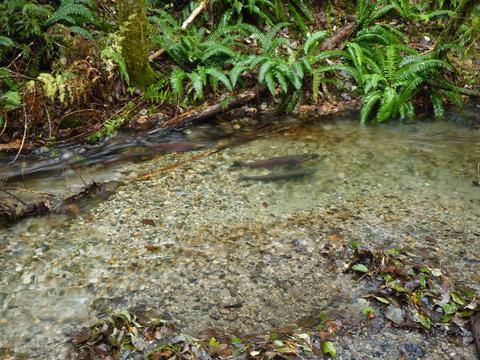当前位置:
X-MOL 学术
›
Ecol. Evol.
›
论文详情
Our official English website, www.x-mol.net, welcomes your
feedback! (Note: you will need to create a separate account there.)
Spatial and environmental effects on Coho Salmon life history trait variation
Ecology and Evolution ( IF 2.3 ) Pub Date : 2020-10-17 , DOI: 10.1002/ece3.6912 Kimberly M F Tuor 1 , Daniel D Heath 2 , J Mark Shrimpton 3
Ecology and Evolution ( IF 2.3 ) Pub Date : 2020-10-17 , DOI: 10.1002/ece3.6912 Kimberly M F Tuor 1 , Daniel D Heath 2 , J Mark Shrimpton 3
Affiliation

|
Adult size, egg size, fecundity, and mass of gonads are affected by trade‐offs between reproductive investment and environmental conditions shaping the evolution of life history traits among populations for widely distributed species. Coho salmon Oncorhynchus kisutch have a large geographic distribution, and different environmental conditions are experienced by populations throughout their range. We examined the effect of environmental variables on female size, egg size, fecundity, and reproductive investment of populations of Coho Salmon from across British Columbia using an information theoretic approach. Female size increased with latitude and decreased with migration distance from the ocean to spawning locations. Egg size was lowest for intermediate intragravel temperature during incubation, decreased with migration distance, but increased in rivers below lakes. Fecundity increased with latitude, warmer temperature during the spawning period, and river size, but decreased in rivers below lakes compared with rivers with tributary sources. Relative gonad size increased with latitude and decreased with migration distance. Latitude of spawning grounds, migratory distance, and temperatures experienced by a population, but also hydrologic features—river size and headwater source—are influential in shaping patterns of reproductive investment, particularly egg size. Although, relative gonad size varied with latitude and migration distance, how gonadal mass was partitioned gives insight into the trade‐off between egg size and fecundity. The lack of an effect of latitude on egg size suggests that local optima for egg size related to intragravel temperature may drive the variation in fecundity observed among years.
中文翻译:

空间和环境对银鲑鱼生活史性状变异的影响
成虫大小、卵大小、繁殖力和性腺质量受到生殖投资和环境条件之间权衡的影响,环境条件影响了广泛分布的物种种群中生命史特征的进化。银大麻哈鱼Oncorhynchus kisutch的地理分布范围很广,整个分布范围内的种群都经历着不同的环境条件。我们使用信息论方法研究了环境变量对不列颠哥伦比亚省各地银鲑鱼雌性体型、卵子大小、繁殖力和繁殖投资的影响。雌性体型随着纬度的增加而增大,并随着从海洋到产卵地点的迁徙距离而减小。孵化期间砾石内中等温度下的卵尺寸最小,随着迁徙距离的增加而减小,但在湖泊下方的河流中卵尺寸增大。产卵量随纬度、产卵期温度升高和河流规模的增加而增加,但与有支流源头的河流相比,湖泊以下河流的产卵量有所减少。相对性腺大小随着纬度的增加而增加,随着迁徙距离的增加而减少。产卵场的纬度、迁徙距离和种群经历的温度,以及水文特征(河流大小和源头)都会影响生殖投资的模式,特别是鸡蛋的大小。尽管相对性腺大小随纬度和迁徙距离而变化,但性腺质量的划分方式可以深入了解卵子大小和繁殖力之间的权衡。纬度对鸡蛋大小没有影响表明,与砾石内温度相关的鸡蛋大小的局部最优可能会导致多年来观察到的繁殖力的变化。
更新日期:2020-12-03
中文翻译:

空间和环境对银鲑鱼生活史性状变异的影响
成虫大小、卵大小、繁殖力和性腺质量受到生殖投资和环境条件之间权衡的影响,环境条件影响了广泛分布的物种种群中生命史特征的进化。银大麻哈鱼Oncorhynchus kisutch的地理分布范围很广,整个分布范围内的种群都经历着不同的环境条件。我们使用信息论方法研究了环境变量对不列颠哥伦比亚省各地银鲑鱼雌性体型、卵子大小、繁殖力和繁殖投资的影响。雌性体型随着纬度的增加而增大,并随着从海洋到产卵地点的迁徙距离而减小。孵化期间砾石内中等温度下的卵尺寸最小,随着迁徙距离的增加而减小,但在湖泊下方的河流中卵尺寸增大。产卵量随纬度、产卵期温度升高和河流规模的增加而增加,但与有支流源头的河流相比,湖泊以下河流的产卵量有所减少。相对性腺大小随着纬度的增加而增加,随着迁徙距离的增加而减少。产卵场的纬度、迁徙距离和种群经历的温度,以及水文特征(河流大小和源头)都会影响生殖投资的模式,特别是鸡蛋的大小。尽管相对性腺大小随纬度和迁徙距离而变化,但性腺质量的划分方式可以深入了解卵子大小和繁殖力之间的权衡。纬度对鸡蛋大小没有影响表明,与砾石内温度相关的鸡蛋大小的局部最优可能会导致多年来观察到的繁殖力的变化。











































 京公网安备 11010802027423号
京公网安备 11010802027423号